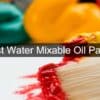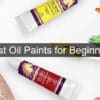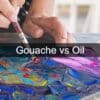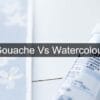Oil Sticks vs Oil Pastels
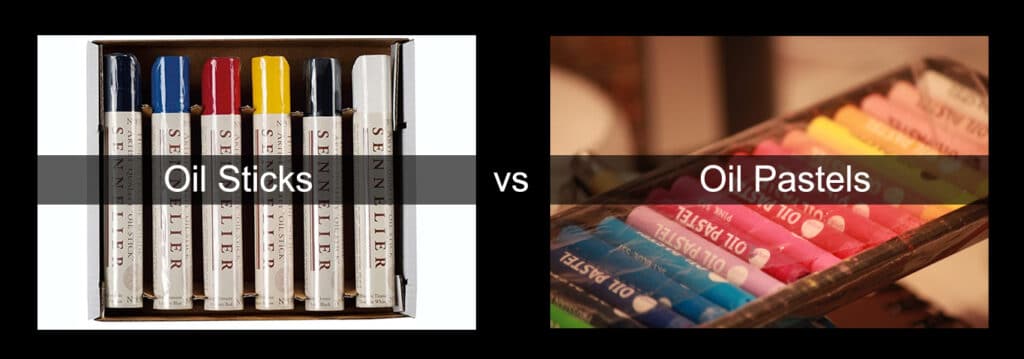
All artists have their unique styles and they prefer different art supplies to develop these painting styles. Oil sticks and oil pastels are two of the most well-received painting medium among many artists.
Oil pastel and oil stick provide excellent performances considering the pigment, colour options, and convenient usage without much preparation. The paints consist of pigments, oil, and wax. They might look like crayons, but these paints consist of oil, unlike crayons.
Judging by the names and same ingredients of the oil pastels and oil sticks, one can mistake them to be the same kind of paints. But each of the paints has unique characteristics that make enormous differences for artists.
Both of the paints have a vast number of colours available. The reason for the availability of colours is that they are hard to blend and make new colours. Because of that, different shades of primary colours are needed.
The blending of oil pastels and oil sticks paints mainly happens using hand, brush, paper towel, Q-tip, tissues, blending stumps, etc.
The ingredients of the paints are the same, but the ratio of the ingredients varies greatly. The oil paint sticks have less wax than the oil pastels, and because there is more wax in them, oil pastels have a hard consistency compared to the oil paint sticks.
On the other hand, the oil paint sticks have more oil in the pigment sticks. That oil makes the consistency of the product relatively soft. The pigment is richer and blends well because of the paint’s smooth texture.
There are several expensive and inexpensive brands available in the market. There are also student grades that are less expensive compared to artist-quality paints.
A student-grade set of oil paint sticks and oil pastels will work just fine as a starter set. That way, there would be no heavy hit on the bank balance. But for more pigment and high quality, experts recommend professional paint sets. Because the quality difference between expensive and inexpensive paint is visible on a canvas, the painter will also realize the difference through the brush strokes.
Disclaimer – This website contains affiliate links. If you find the information useful and click on a product link and make a purchase, a small commission will be earned by Big Red Illustration
What are oil sticks?
Oil stick, also known as oil bar or paint stick, is like regular oil paint in stick form. They have almost all the attributes of oil paint in handling properties, but oil sticks win when it comes to convenience and immediacy. The colours can be purchased in a set or single colour like oil paint, as the artist wishes and has excellent colour pigmentation.
The paint sticks contain pure pigment mixed with a wax binder and drying oil like linseed oil and safflower oil. After blending the color and oil ends, they are shaped like stick form and wrapped with paper.
The oil stick provides intense colors and pigment. The drying oil used in the paint sticks helps it dry completely, unlike oil pastels. It is very similar to regular oil paint. Because they can completely dry out like traditional oil paints, and they are compatible with oil paints too.
The artists can use the paint oil sticks on a canvas directly as it is. The artist can also use the pigments sticks in various other ways, such as – mixing on color palette, using a painting brush or palette knives, mixing with another medium, such as oil paints. The possibilities are endless.
Artists cannot directly use oil sticks on a surface. The surface needs to be primed before the painting process, just like oil paint requires. Otherwise, there will be oil leaching, and the longevity of the painting will be less.
The consistency of the oil sticks is like thick oil paint. This paint can be used on many surfaces such as canvas, watercolor paper, even panels made of aluminum and wood. The drying times may vary from brand to brand of oil sticks, but they will eventually dry out with time.
This medium gives off painterly effects on the art, providing an abstract feeling to the painting. The oil sticks can be used using brushes. Painters can also use extra drying oils like linseed oil to make the stocks softer and rich in color.
What are oil pastels?

Oil pastels are pigment sticks that contain pigment and binding elements like non-drying mineral oil and wax. Oil pastel has vibrant color. It can be purchased single or in a set, just like oil sticks.
Many artists believe that oil pastels are a mixture of soft pastels and crayons. But soft pastels and crayons are drier compared to oil pastels. One disadvantage of oil pastels is that it does not have as many color options as soft pastels. Moreover, soft pastel dries out faster, unlike oil pastels.
Soft pastel does not have any oil in it. The binder of soft pastel consists of gum and pigment. That gives it chalk-like consistency. The oil pastel has oil that makes it smooth and soft like oil paint.
Oil pastels do not completely dry out no matter how much drying time it gets. The painting may harden over time, but because it has non-drying oil, oxidation never occurs. So, the pastel remains workable for as long as the painting exists.
No other media of pastels contain any oil in them. For example, soft pastels include gum and methylcellulose as their binder. Artists can use oil pastels on different surfaces, including paper, canvas, wood, etc.
Oil pastel does not require any preparation as oil paint does, and artists can start painting right away. This attribute makes oil pastel an attractive choice.
These pastel sticks can be diluted with mineral spirits and turpentine. It gives off painterly effects to the painting.
If the temperature is above 80 degrees, the paint sticks can become soft and melty. To avoid such a disaster, painters should place the paint sticks in ice, inside a cooler.
Many artists state that the characteristics of oil pastels are similar to crayons when others disagree entirely. Oil pastels have a creamy and soft consistency. The pastel helps the artists to blend, smear and mix the paints in a painting.
On the other hand, crayons have hard skin. Mixing two crayon colors is nearly impossible, unlike the oil pastel.
Artists use a variety of tools to blend oil pastels. Such as – paper towels, palette knife, tortillon, q-tip, etc.; it can also be used with an oil painting medium for better blending.
Difference between oil sticks and oil pastels
Oil bars and oil pastels have the same ingredients, such as – pigment, oil, and wax. So, some might say they are identical. But they are not the same when it comes to painting if we consider the ratio of the ingredients and types of ingredients used in it. The main difference is in the oils used in both paints.
Oil bars contain drying oil; it dries out with time, just like an oil painting. On the other hand, the oil pastels medium contain non-drying oil that does not dry out. So it tends to smudge if a painting has thick layers on it.
After finishing the painting, it needs a glass frame or varnish to be protected. The plus point of oil pastel is that it will still be blendable no matter the drying time.
Oil paint sticks come in larger sizes compared to pastels oil sticks. The oil sticks have an extra cost because of the larger quantity of the product.
Since the oil paint sticks contain more oil than the oil pastels, it is soft and has vibrant color, much like an oil painting. So, most oil painters use them as well.
On the other hand, oil pastels contain more wax compared to oil sticks. The consistency is more like soft pastel. The blending is easier for oil sticks compared to oil pastels.
The storing of oil pastels does not require special attention, but the maintenance of oil paint sticks does because it forms a hard layer on top that needs to be removed.
If the oil paint stick is left unused for a very long time, the layer would be stubborn enough to use blades to scrape out the hard skin. But the inside would still be soft and appliable.
Combining oil pastels with oil sticks
If artists want to combine oil pastels and oil sticks in a painting, they can do that separately. But there is some critical guideline to be aware of for better results.
When combining the two paint, one should dominate the whole painting while painters can use the other media to add details or accents. It helps with the structural integrity of a painting.
If oil pastels or oil sticks are used for the underpainting of an oil painting, the artist should consider using a thin layer. When the oil paint goes on top, the heat will melt the underpainting, and blending would be better that way.
If artists use oil pastel or oil stick underneath a watercolor or acrylic painting, the wax binder in pastel starts acting up and creates a barrier. It will work for oil paint if the application is thin.
Since oil pastels do not dry out completely, artists should be mindful of their usage in a painting. They should use it for detailing purposes on their art. It will help to minimize smudging.
Artists should be mindful about not using a thick layer of oil pastel on their oil paintings. Since the pastel paint does not dry out, it will stay unstable for as long as the oil paintings exist and may cause cracking on the art.
Best brands

Sennelier oil sticks and oil pastels are highly pigmented. It tends to give more freedom to the painter. The artist-quality Sennelier paints have board strokes and more depth. This brand has approximately 55 colors available at the time of writing. The formulation of the Sennelier has a small amount of siccative. Siccative is a drying agent that helps the paint to dry out faster.

Winsor and Newton oil bars are slightly cheaper than the Sennelier oil sticks. They are a bit stiffer on consistency as well. The paint can take up to two days to dry completely.
The most high-end brand R&F pigment sticks are the most expensive among these three. It is also highly pigmented and produced in small batches. Moreover, they are made of natural bee wax. The R&F is well known for its consistency, similar to the lipsticks.
The handling properties and composition of the pigment sticks vary from brand to brand. Considering the pigments, and features of paints, we can assume these are three of the best brands available in the market. But there are many other brands with cheaper options. The student grade paint tends to have less pigment and is harder than the artist grade paint. But as a starter set, inexpensive paint sticks will do the work.
Application of oil sticks
Oil sticks come wrapped with paper. Artists need to remove the wrapper before using it. An essential fact about oil paint sticks is that when it is left unused, a thick layer forms on top of it. It happens because the oil hardens because of the air.
Without removing this thick layer, a painter cannot use it properly. So, artists should remove it by dragging the end of the stick on any hard surface.
Dipping the oil paint sticks on an oil paint thinning medium, like safflower oil, will provide even softer, smooth lines. It will give off the feeling of oil paint.
This hard skin needs to be removed before using it every time. It occurs because of being exposed to air.
The application of the oil paint sticks entirely depends on the artist. They can use them for initial sketches or highlights or even for the entire painting process.
The thickness and colorfulness of the lines depend on the pressure. If the oil paint sticks are pressed hard, the lines will have more pigment and consistency and it will have painterly effects.
Artists can use oil sticks just like oil pastel and create the vibrant color and texture they would like on their art.
As the pigment sticks take up to two days of drying time, they will remain blendable to some extent with the pigment sticks. The drying time varies depending on the application of the pigment sticks. If the oil paint sticks are applied thickly, the drying time will be longer.
The painters can layer the oil paint colors with regular oil paints to create beautiful artwork on a canvas.
Painters cannot use the oil paint sticks straight away on the surface like an oil pastel. The surface needs to be primed to bring through the rich color of the oil stick. It is also one of the reasons that suggest, oil stick and oil pastel are not the same painting mediums because in pastel painting, the artist does not require to prime the surface.
An oil stick is like an oil pencil. The shape makes it easy for the artists to build texture and gives more control on the strokes.
Professional artist and oil pastels
As per artist Pablo Picasso’s request, the first oil pastels, Cray-pas, were made for professionals. The purpose was to have a ready paint set that artists could paint right away without preparing the canvas. They are ready to be used on location and great for travelling.
They give vibrant colour just like oil paints. Moreover, cleaning up only requires a paper towel or baby wipes. It will get the colours off effortlessly.
Oil pastel provides excellent texture and versatility, just like oil paint. Moreover, it does not have any harsh chemical smell to it. All this makes it a better option compared to the oil paint.
Artist does not require to work too hard to get the rich colour out of the pastels without causing any health issues.
Unlike oil paint, oil pastel does not have any harmful chemicals that cause serious health issues.
These paint sticks are very travel-friendly. Painters can use oil pastels right away without needing any preparations like – priming the surface, requiring any paint brushes, solvent, etc. It is also convenient for quick practices.
The colors of oil pastel have high pigment. It makes the art look lively and well textured.
Soft pastels are one of the most common pastels that artists use. But it is hard and not as smooth and appliable as oil pastel. That is why many professional artists choose oil pastel over soft pastels.
It is an oil-based paint that does not oxidize (does not dry out by exposure to air). It makes the color more playable. Though it is not as blendable as soft pastels, its unique features help create various interesting textures that artists love.
Oil pastels are applicable on any surface, unlike oil sticks, rough, smooth, woody, metal, or glass. Artists can also use many tools, including hands, to blend the colours, since the paint sticks are soft and have rich pigment.
Artists can achieve a painterly effect that gives the oil pastel painting tremendous depth.
All these advantages encourage professional artists to use oil pastels as a medium.
In closing
That brings us to the end of this article and as ever, I hope it has been informative and useful. Have fun trying out these two mediums as both have plenty to offer and remember to keep on trying different styles and techniques as you never know when the perfect process will come your way.
Affiliate Disclosure
In compliance with the FTC guidelines, please assume the following about all links, posts, photos and other material on this website: Any/all of the links on this website are affiliate links of which The Big Red Illustration Agency receives a small commission from sales of certain items, but the price is the same for you. www.bigredillustrationagency.com is a participant in the Amazon Services LLC Associates Program, an affiliate advertising program designed to provide a means for sites to earn advertising fees by advertising and linking to Amazon.com & Amazon.co.uk. Pages on this site may include links to Amazon and its affiliate sites on which the owner of this website will make a referral commission.
FULL TERMS HERE Cookie preferences: cookie preferences

Written By Adam Rushton
Adam has made a name for himself in the illustration industry and is a passionate blogger and writer on the subject of art, illustration and graphic design.
His artwork has been featured in countless publications and used for very well-known media projects. As a professional illustrator for over 20 years, Adams media outlets, a wealth of knowledge, and experience enable him to consult and advise artists and illustrators in this country (from York and Manchester to Southampton and London) and all over the world.













